In 2020, we wrote a detailed case study on how we grew a B2C blog to 70,000 pageviews in 14 months. In that post, we discussed the content strategy we used—along with data on the rankings, leads, and traffic results we achieved for them.
In contrast to that article—which told the story of our content strategy through the lens of a single client—this post will discuss B2C content marketing more broadly.
Specifically, we’ll cover:
Curious about having us do content marketing for your business? You can learn more here.
If you’d like to learn the content marketing strategy that we share here, we also teach our content marketing process in our course and community.
3 Problems with the Way Most Businesses Do B2C Content Marketing
We see three core problems with the way most B2C brands do content marketing:
- There’s too much focus on top of funnel “lifestyle” content.
- It leaves a ton of high value SEO keyword opportunities on the table.
- There’s not enough emphasis on creating high-quality content.
Let’s look at each.
Problem #1: It’s Focused on “Lifestyle” (Top of Funnel) Content
The first and biggest problem we’ve noticed is that the vast majority of B2C businesses that produce content focus on “lifestyle” content—or what we call “top of funnel” content. It’s created primarily for branding purposes, not for selling their actual product.
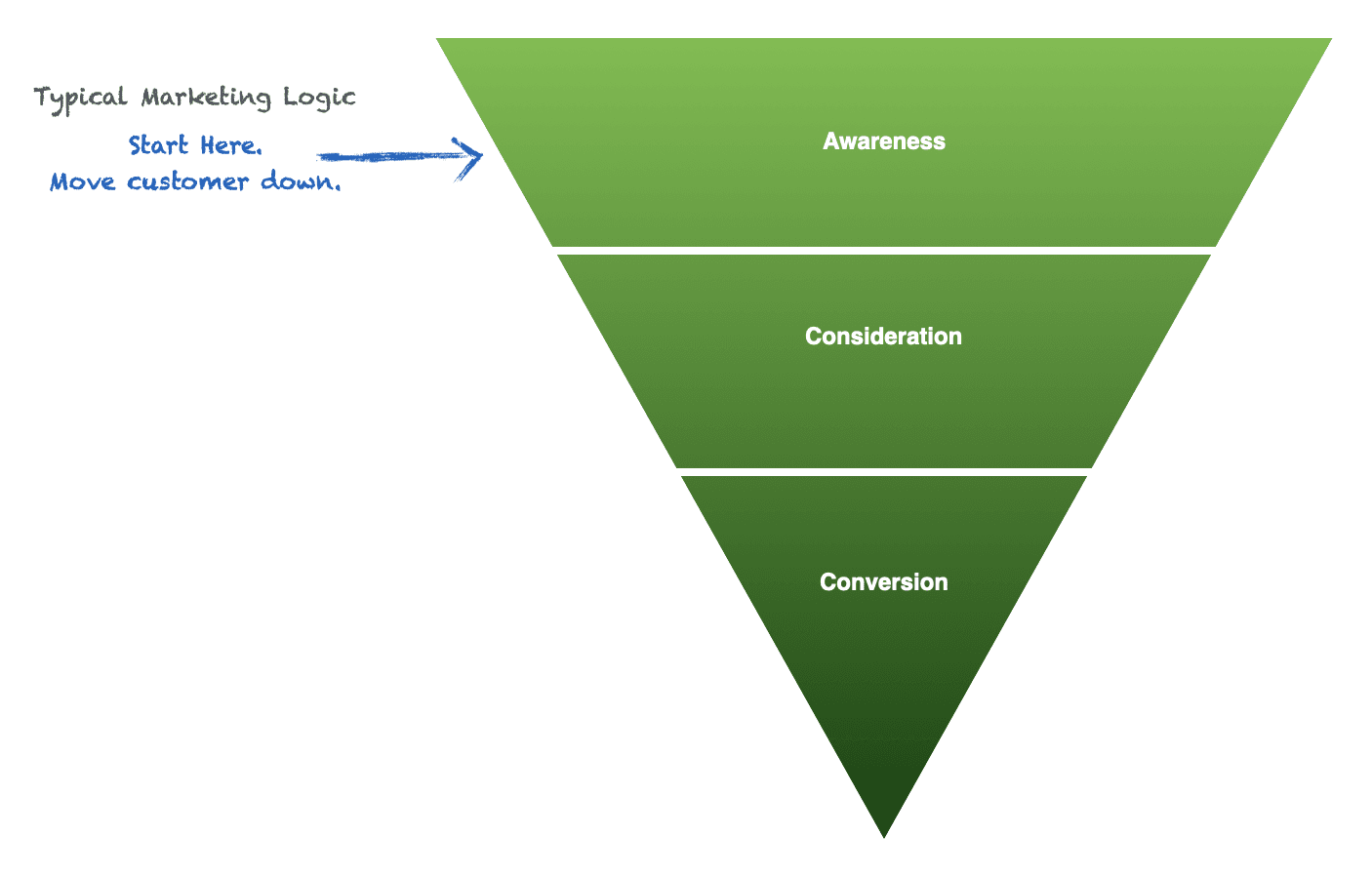
The typical argument for focusing on this type of content is that it generates brand awareness, is appealing to their target audience, and that once people are exposed to their brand, they’ll be more familiar with it and more likely to buy something in the future (whether through email marketing, a social media post, retargeting ad, etc.).
Another common argument for a top of funnel, lifestyle-heavy approach like this is that it isn’t too “salesy”. There’s a common school of thought in the content marketing community that you don’t want to be “pushy” in your content, so you should not sell or talk about your product much, instead just offer helpful advice in the subject-area and people will grow to like your brand and buy later. Unfortunately, as many posts on our site show, top of funnel content like this converts way worse than bottom of funnel. The more you talk about your product (appropriately) the more sales you get from content.
Don’t get us wrong, there’s absolutely a place for lifestyle marketing content in B2C. But if you look at companies that do this well, they use a high-quality, journalistic approach. The popular women’s clothing company M.M. Lafleur is a good example of this. Their blog “The—M—Dash” features exclusive interviews with women celebrities and influencers that take a lot of resources to create. For example, you can’t easily get an interview with Padma Lakshmi like this, this is basically like creating a digital magazine attached to your eCommerce brand:
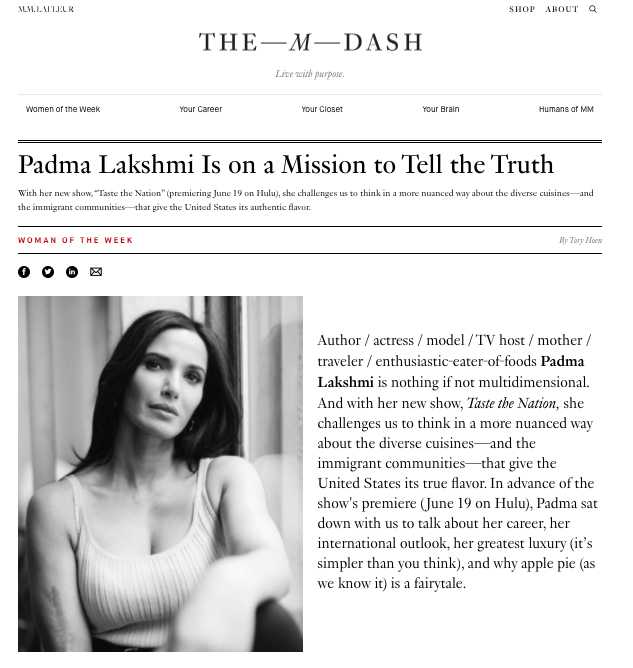
But this is not what most B2C businesses do. Most business to consumer companies try to farm out this type of content to freelancers and hope for similar results. The freelancers choose random topics that are loosely connected to their space (e.g. “best hiking trails” for an outdoor apparel company), and produce thin, unoriginal content.
So these brands end up getting the worst of both worlds: Not only do the topics not directly relate to selling their actual product (so they barely convert to sales), but the lifestyle content does little to impress or engage potential customers (so they don’t give you much brand building either).
Problem #2: It Leaves a Ton of High Value SEO Keyword Opportunities on the Table
When B2C businesses focus their blogs entirely on top of funnel (TOF) topics where purchase intent is low, the only pages on their site that will potentially rank for bottom of funnel (BOF), high purchase intent keywords are their product pages.
There are several problems with this.
First, the BOF keywords that product pages are built to rank for are often highly competitive because every competitor in that space is going after those same head terms. This makes it difficult to rank product pages to begin with.
And second, even if a product page ranks for a few of your product category keywords (e.g. “running shoes”, “running shoes for men”, etc.), there are often tons of lower competition, “long tail” variations of those keywords (e.g. “running shoes with arch support”) that general product pages will never rank for because they aren’t tailored for those specific terms (more on why this is below).
This leads B2C businesses to leave a ton of high value keyword opportunities on the table.
Here’s a quick example to demonstrate what we mean:
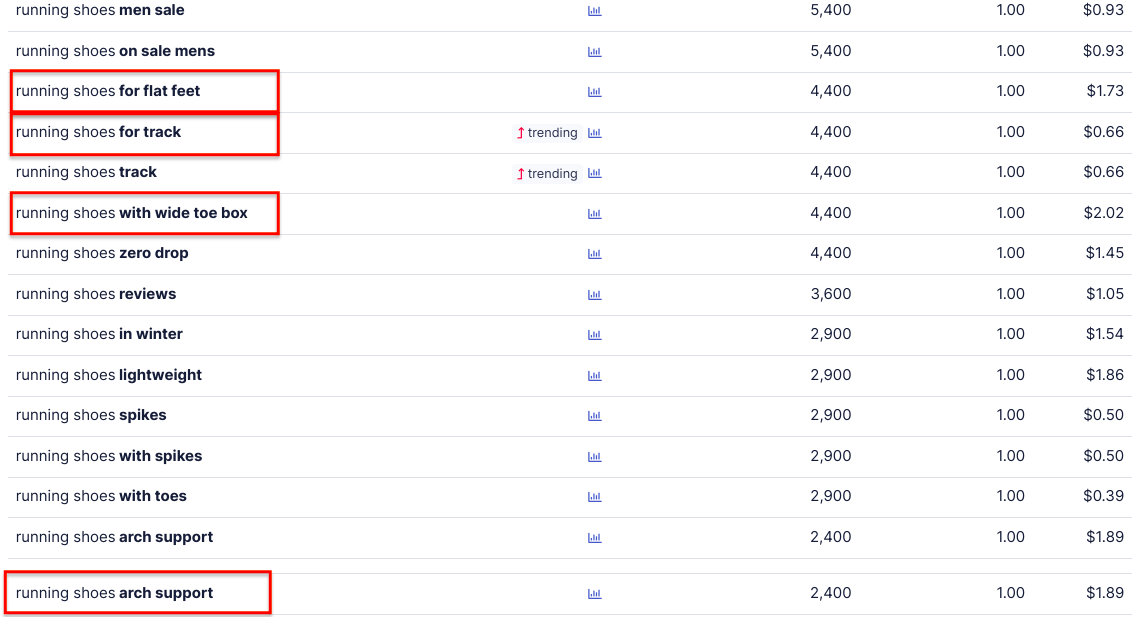
When we search for the query “running shoes” in our SEO tool Clearscope, we see examples of long tail product keywords that have high purchase intent and that most businesses are unlikely to rank for with their general “running shoes” product page (as evidenced in the screenshot below).
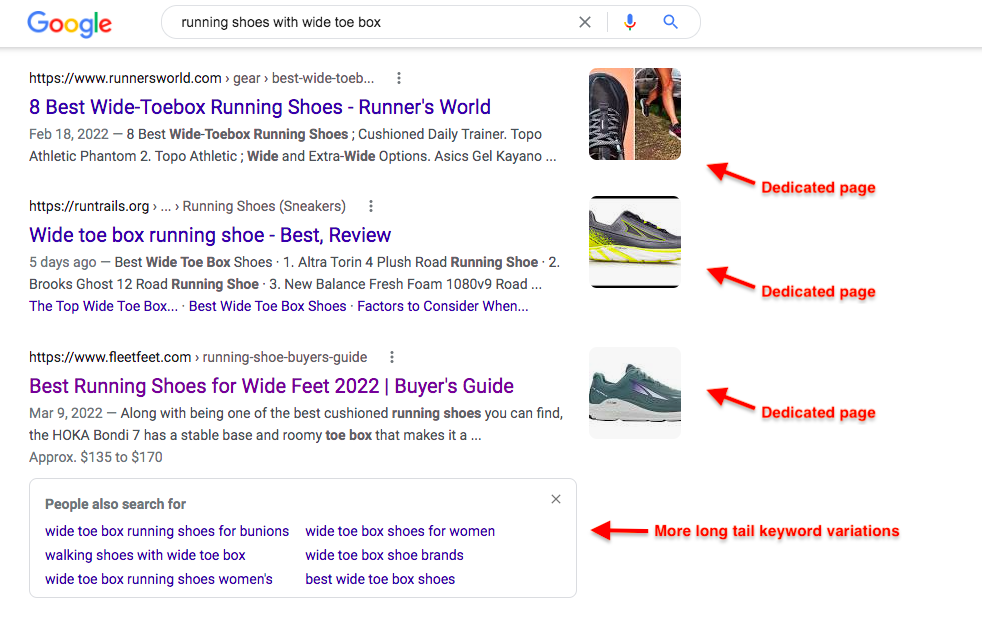
There are no general product pages ranking in the top search results for “running shoes with wide toebox”. Each top ranking result is a specific page dedicated to that specific topic.
These are the types of queries we go after in our B2C content strategy because they show high purchase intent, have lower competition, and require dedicated pages to rank for which blog posts can do very effectively.
If you happen to sell running shoes that are good for flat feet or have arch support, these are incredibly valuable keywords to rank for because the buying intent of these searchers is extremely high. In particular, if you can rank with a page that explains exactly how and why your shoes are good for those use cases, it should produce a steady flow of buyers. You just need the right strategy to do that (not just “sprinkling” these keywords in existing pages).
We’ll explain our strategy further in a moment.
Problem #3: There’s Less Emphasis on Quality
Related to problem #1 above, where we mentioned most B2C content is outsourced to freelancers, is the issue that there is overall less emphasis on quality content in B2C compared to B2B.
In the B2B space, companies sell to a technical or advanced customer base, so there’s generally an awareness by B2B marketers that they need to produce advanced content for it to be effective. (In reality, many B2B companies still produce “white papers” and “ultimate guides” that are too beginner for their audiences, but that’s a story for a different post.)
In contrast, many consumer-facing brands think that because B2C customers are largely beginners, they can hire any writer to produce their content. But this leads to uncompelling, undifferentiated content that doesn’t reflect well on the brand and doesn’t rank for strategic keywords that drive business value.
(For example, in the running shoes example above, a super basic “10 tips for runners” post full of cliche tips about stretching and consistency that every runner has heard a thousand times.)
Combined, these 3 problems have the following implications:
- No measurable ROI: Their content doesn’t lead to sales.
- Ineffective brand building: Their “lifestyle” content does little to generate positive brand awareness.
- Low SEO impact: Competitors outshine and outrank them in search engine results pages (SERPs), and they leave a bunch of high value keyword opportunities on the table.
Now, let’s look at our agency’s approach to B2C content marketing which solves these problems.
Our B2C Content Marketing Strategy: Start with Bottom of Funnel and Work Your Way Up
We’ve written a lot about our bottom of funnel-first content strategy (which we use for both our B2B and B2C clients). In this section, we’ll summarize the theory behind it in the context of B2C content marketing. And below, we’ll share links to our articles that explain it in depth.
Over the last 4 years of running our agency, we’ve learned that producing bottom of funnel SEO content is arguably the most effective strategy for getting ROI from content marketing.
The logic is simple: When people Google terms that indicate they are searching for a product or service you sell, and you show up in search results with a compelling pitch for your product or service in that space, you are showing up in front of prospects that are ready to buy. The keywords they’re searching for reveal their readiness to buy.
In contrast, educational content about peripheral topics in your space—the type of content that’s meant for social media promotion or non-buying search terms—does not have this advantage. This content may be good for getting your brand name in front of potential future buyers, but the act of reading informational, how-to style content doesn’t automatically indicate the reader is ready and willing to buy now.
So, instead of focusing on top of funnel content creation like most other agencies and businesses, our content strategy focuses on targeting:
- BOF product keywords: Product search queries that our B2C client’s general product pages won’t rank for.
- Pain point keywords: Search queries that indicate someone has a pain point that our client’s product solves.
- Use case keywords: Search queries that indicate someone wants to do something our client’s product helps them do.
We call this strategy Pain Point SEO.
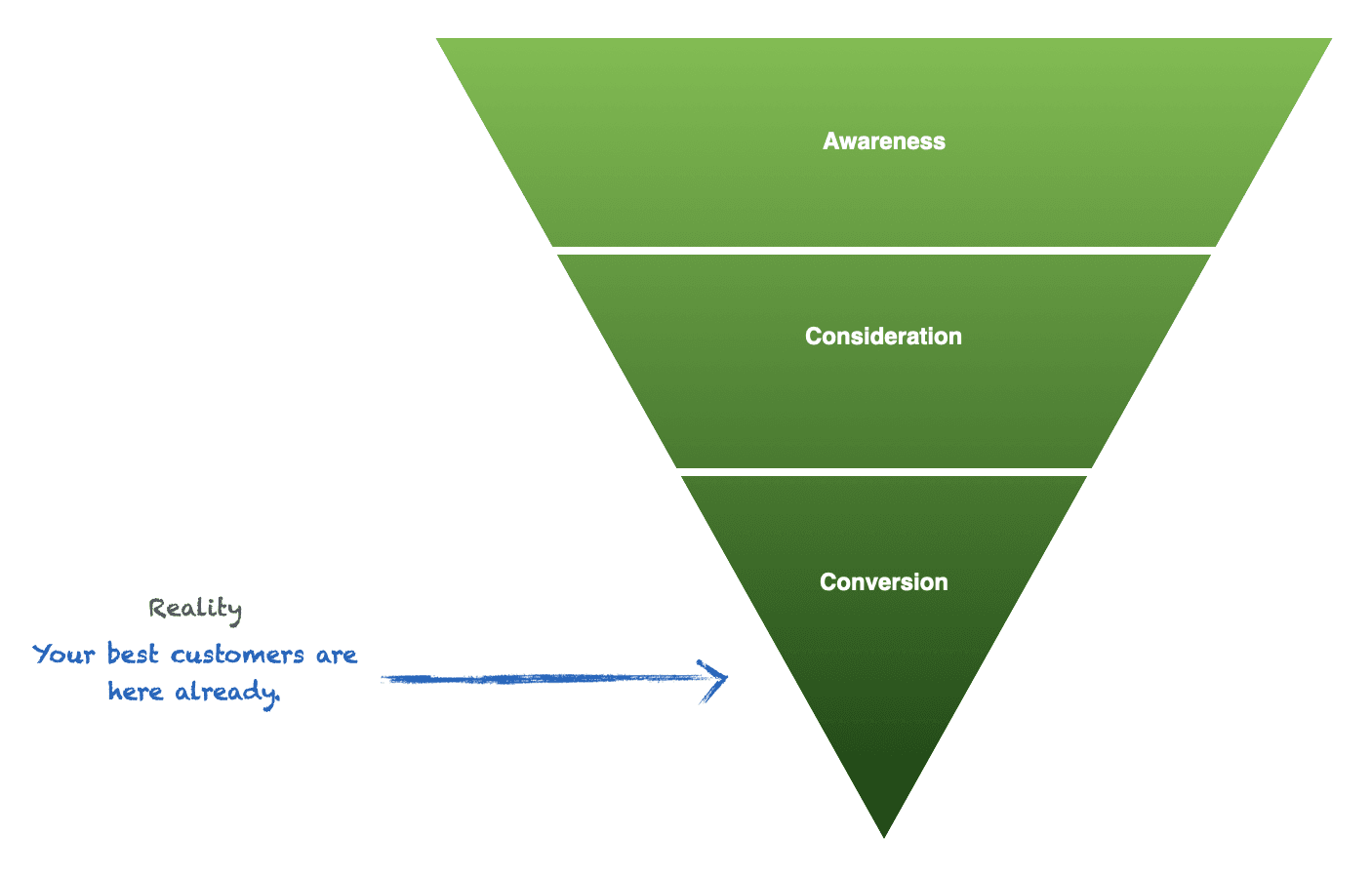
As a result of this approach, content is able to convert much higher and produce more conversions than TOF content—despite having much lower search volume and traffic potential than many TOF keywords.
To read more about this strategy, check out these past articles:
- Pain-Point SEO: How to Produce SEO Content That Drives Conversions
- Content Ideation: Ways to Come Up with Content Ideas That Convert
- B2C Content Marketing Example: How We Grew Cognitive FX to 70,000 pageviews in 14 Months
- Scaling Content: Expanding from Bottom of Funnel Content to Top of Funnel (Geekbot Case Study)
Below, we’re going to show examples to demonstrate how this works in practice. But first, let’s quickly cover how B2B and B2C content marketing differ because there are some key considerations that B2C businesses should be aware of.
B2B Content Marketing vs. B2C Content Marketing: The Differences That Actually Matter for B2C Companies
A lot of what people say online about B2B versus B2C content marketing is centered around how audiences differ. For example, you often hear that there are more “personas” to tailor messaging to in B2C, but, if you use the strategy we discussed above, this is largely irrelevant because you can produce content tailored to search queries regardless of who is typing those terms into Google.
In our experience, the differences that actually matter are mostly absent in current articles on this topic. Specifically, there are 3 key things that B2C business owners and decision-makers need to understand before allocating budget to content marketing.
Let’s look at each.
1. The Average Order Value is Usually Much Lower in B2C Compared to B2B
There are obviously exceptions, but in general, B2B products and services tend to cost a lot more than B2C products and services. For example, many direct to consumer and eCommerce brands have an average order value (AOV) of $100 or less, while many B2B SaaS companies have an average revenue per user (ARPU) of $100,000 per year.
This makes a huge difference in what you can afford to spend in a channel to get one lead or one closed sale. Specifically, for the lower priced B2C companies, the number of conversions you need to break even or generate positive ROI is significantly higher.
Some enterprise B2B companies with ARPUs like those above, for example, might break even with 10 leads per month. But in B2C, due to the much lower price of products, it could be 10X or 100X that (or more). You need to rank for a lot more keywords for investments in content to be worth it.
This decision is very context dependent. Specifically, companies need to consider:
- How much would it cost to do content marketing properly?
(For reference, our agency charges $10k/mo. Or maybe you’re considering full time employees.)
- How many sales attributable to content would you need per month to break even?
You can get this with simple division from the investment number above (e.g. $10,000 per month for a content agency divided by $100 AOV is 100 sales per month). This is your breakeven conversion goal.
- How much traffic would you need to get to that breakeven conversion goal?
(Assume a traffic to conversion rate from your content of between 0.1% and 0.75%.)
- How long are you willing to invest in content marketing to get to that point?
(For example, if you need to get to 2 million visitors/month, that may take a couple years or more.)
- And how does that look in relation to the performance and ROI of your other channels?
For some companies, they’ll do this math and find that the numbers make sense and are worth it to them. For others, investing in content marketing may not be a good idea right now. The important thing is to do this napkin math and get perspective on this before committing an investment to content marketing.
The good news: To meet this demand for more traffic and conversions, B2C also tends to have a much higher volume of keyword opportunities.
2. There’s a Higher Volume of Keyword Opportunities in B2C
There are way more consumers than there are businesses, so the volume of people searching for consumer products and services is generally much higher than the volume of people searching for B2B products and services.
This means that search volume—the number of monthly searches for a given keyword—as well as traffic potential, tend to be significantly higher in B2C. And with more people searching for B2C products, there also tends to be a lot more variations of what people call products and services—so it’s not uncommon for B2C businesses to have 5X or 10X more keyword opportunities than the average B2B business.
The positive implication of this is that more keyword opportunities make it possible to meet the need for more traffic and conversions to get positive ROI. The challenge is that you need to create a higher volume of content to take advantage of those opportunities.
3. There’s Often More Competition in the SERPs in B2C
Finally, in a lot of cases, there’s many more brands to compete with when creating SEO content in the B2C space. While it’s common for B2B companies to have 5 to 10 main competitors, B2C businesses often have tens or even hundreds of brands to compete with in the SERPs.
This is why it’s so important to use a strategic approach to selecting keywords to target with your content. If you can see the less obvious opportunities that your competitors are missing—like we’ll demonstrate in the next section—you can own a ton of purchase intent keywords in your space that your competitors aren’t even considering.
Applying Our B2C Content Strategy to a Real Business
Let’s make our strategy more concrete now by discussing how it applies to a real B2C business. Specifically, let’s look at how we’d approach using our content strategy for an outdoor supplement company called Truwild. They sell things like pre-workout and immunity boosting supplements for people into hiking, snowshoeing, and other outdoor sports.
This is Benij’s friend’s company and just a hypothetical look at how we’d implement our strategy if we were working together.
How We’d Approach B2C Content Marketing for Truwild
Like most B2C businesses, blogs in the nutrition supplement space focus on top of funnel “lifestyle” topics. For example, here’s some of the topics covered by a different sports nutrition company:
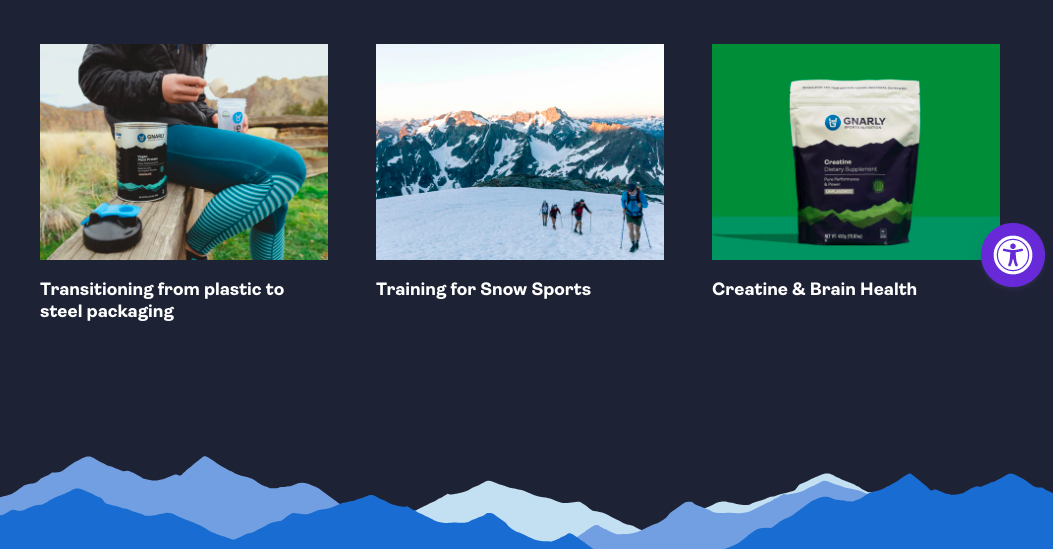
Two of these topics are perfect examples of TOF content. “Transitioning from plastic to steel packaging” and “training for snow sports” are topics that would very likely be interesting to their audience, but neither of them indicate the person searching or reading is looking to buy a natural supplement product.
From an ROI standpoint, as we’ve shown in this case study and in other posts, these types of keywords convert far, far less (often 25X less) than BOTF keywords. As a result, we think it doesn’t make sense to go after these TOF topics when there is such a high volume of keywords that indicate people are looking to buy these types of supplement products.
This is why, as we mentioned earlier, we’d focus our content strategy on three types of keywords before all else:
- BOF product keywords: Purchase-intent keywords that our B2C client’s general product pages are unlikely to rank for.
- Pain point keywords: Search queries that indicate someone has a pain point that our client’s product solves.
- Use case keywords: Search queries that indicate someone wants to do something our client’s product helps them do.
Let’s look at examples of each.
BOF Product Keywords
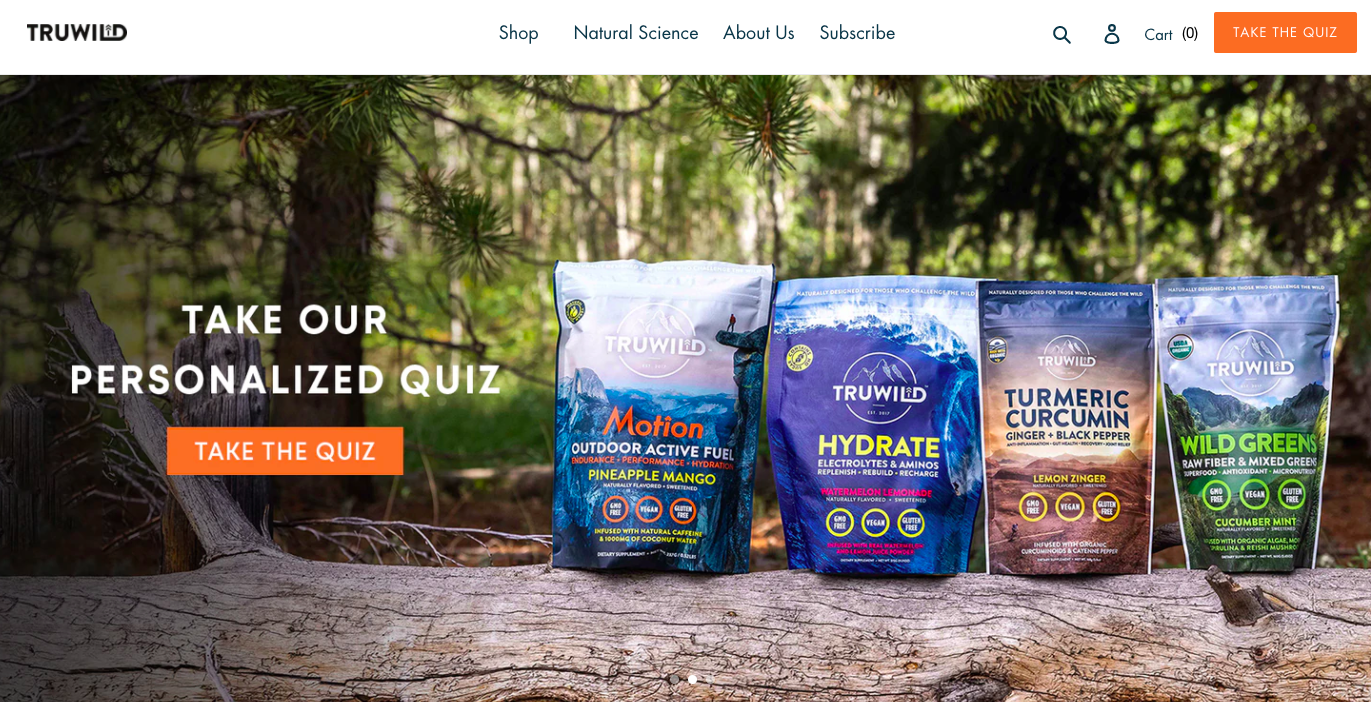
Truwild makes 4 lines of natural supplements for outdoor athletes: Pre-workout, hydration, superfood, and immune support.
Starting at the very bottom of the funnel, you can imagine the types of keywords they might rank for with their individual product pages. For example:
- Natural [product type]
- Natural [product type] for athletes
- Natural [product type] for outdoor athletes
And in fact, these are exactly the types of keywords their product pages are ranking for:
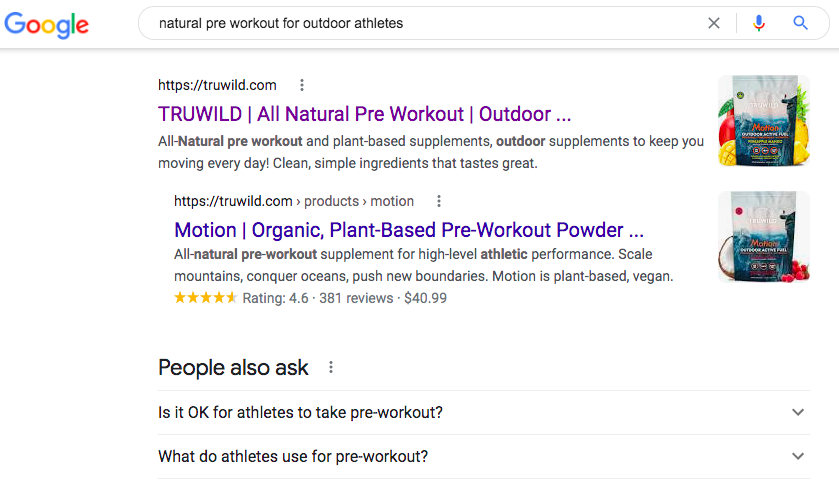
However, there are tons of other ways that people describe these types of products (i.e. There are many other purchase-intent keywords to go after).
For example, here are some terms where their hydration product page is ranking on page 2-4 of search results (you will get essentially zero conversions when ranking on pages 2-4, it’s not much different from not ranking):
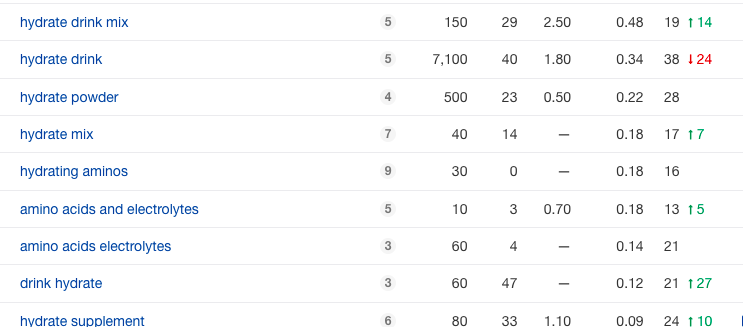
Terms including: “hydration powder”, “hydration drink mix”, and “hydrate supplement”.
All of these terms indicate someone is looking for the exact thing Truwild sells, but it’s possible (and in many cases likely) that their general product page will never rank for these different variations.
This is due to the way Google’s algorithm works. They rank pages based on their ability to satisfy search intent. And highly specialized, specific pages naturally do a better job of that.
So for terms like these, it’s often necessary to create either a page that’s optimized for that specific query, or a list-style post that presents searchers with multiple options. The latter is often what you’ll find get top rankings in the SERPs for queries like these because people searching want to explore options before making purchase decisions, and therefore lists are the best content type for satisfying search intent.
There are many ways to find these types of keyword opportunities. But we’d likely start with the specific keywords that they have included on their product page:
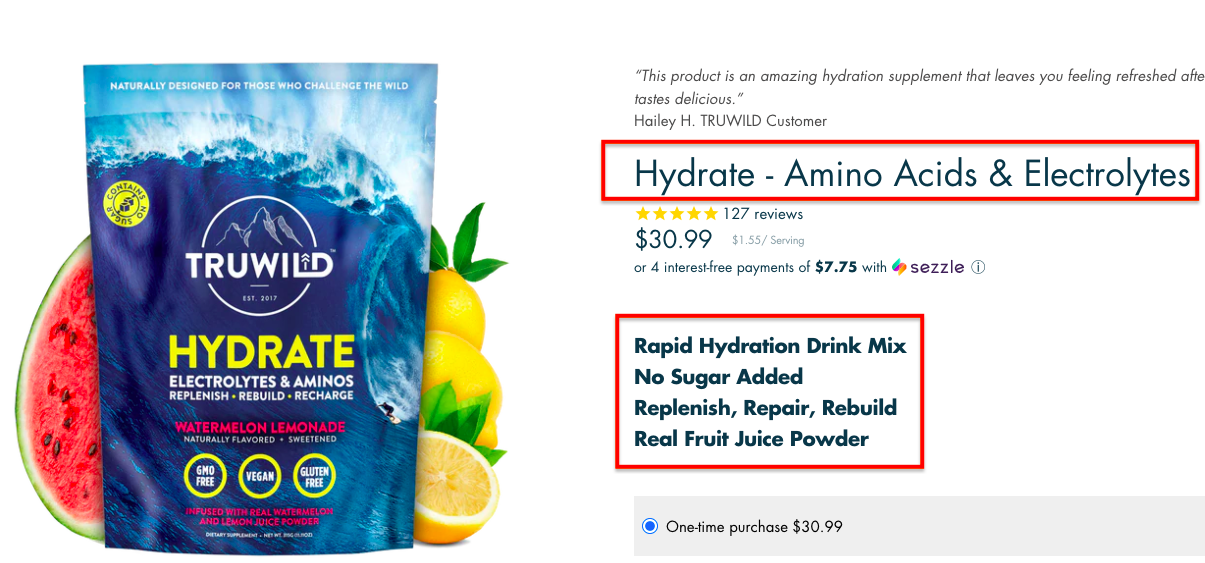
These keywords are hints at potential long tail keyword opportunities. And people looking for hydration drinks with these specific qualities are a perfect match for Truwild (which can produce higher conversion rates than people searching for more general product terms). So for queries that include “hydration drink” with any combination of these other terms, if they aren’t already ranking, we’d want to look at targeting those.
Here are some examples that show up in Clearscope when searching “hydration drink with amino acids”:



Here are some that show up when searching for “no sugar hydration drink”:



The other BOF product keywords we’d look at are competitor keywords. For example, one of their top competitors is a company called Liquid IV. So we might create content for keywords like:



Note how different these keywords are from the TOF examples we showed earlier (transitioning from plastic to steel” and “training for snow sports” — all of these search terms show clear product buying intent.
And we could replicate this with their other close competitors, as well as classic hydration brands like Gatorade. (Think: “Gatorade alternatives”, “Powerade alternatives,” etc.)
In these few short examples, we might have 10+ BOF product keyword opportunities to potentially target, and this is just for one of their four products. We’d replicate this same strategy—both with product and competitor keywords—for each product (i.e. pre-workout, superfood, immune support).
In doing so, you can see how Truwild could be looking at opportunities to rank for 50-100+ revenue generating keywords that they otherwise would have left completely untapped.
Now, let’s look at the types of terms we might target as we move up the funnel away from direct product intent keywords.
Pain Point Keywords
The key benefit of targeting pain point keywords is that searchers often have intent to find a solution and there’s a natural opportunity to tie in and present their product.
To demonstrate how we approach this, let’s take a second to brainstorm possible pain points that Truwild’s pre-workout solves for its customers. Similar to the hydration product keywords discussed above, it’s useful to think about this through the lens of the specific information they include on their product page:
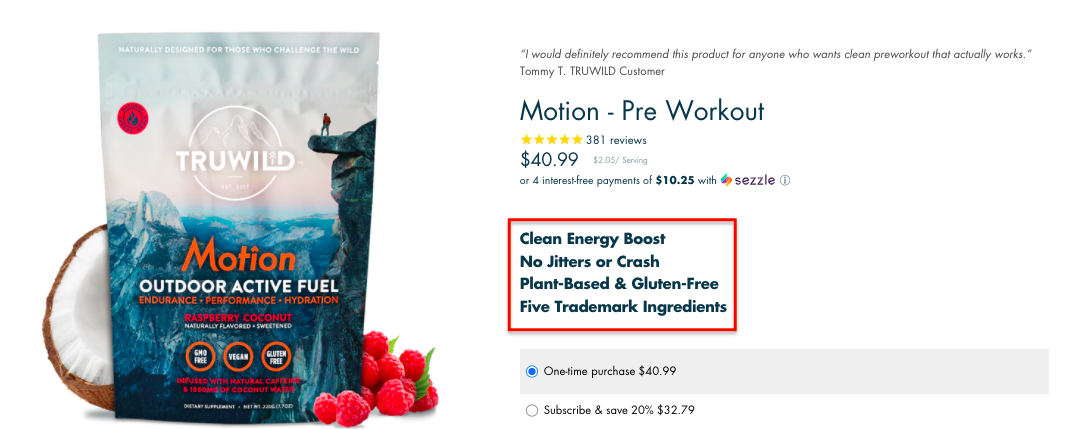
Based on these product qualities, pain points their customers might have include:
- Worries about pre-workout being bad for them
- Jitters from their current pre-workout
- Uncertainty about the ingredients in their pre-workout
- Desire for a plant-based pre-workout
- Need for a gluten-free option
- Crashing after use of their pre-workout
So, if we were doing content ideation for pain point keywords, we’d start searching for these terms in the various tools we use (Clearscope, Google Suggested Search, Google Related Searches, “People also ask”, etc.).
Here are some examples for the jitters pain point:
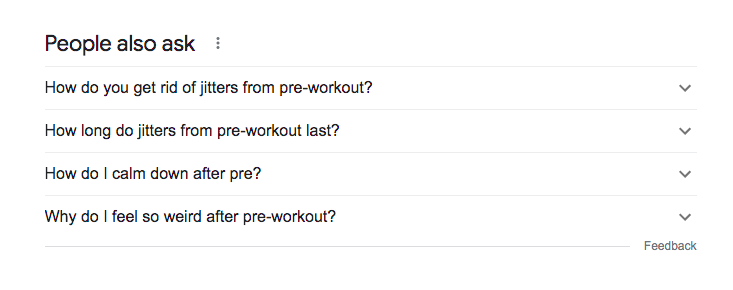
Any of these queries could be opportunities for Truwild to show up, educate readers on why pre-workouts cause jitters, and present their alternative as a solution to that.
Here are some examples for the health pain point:
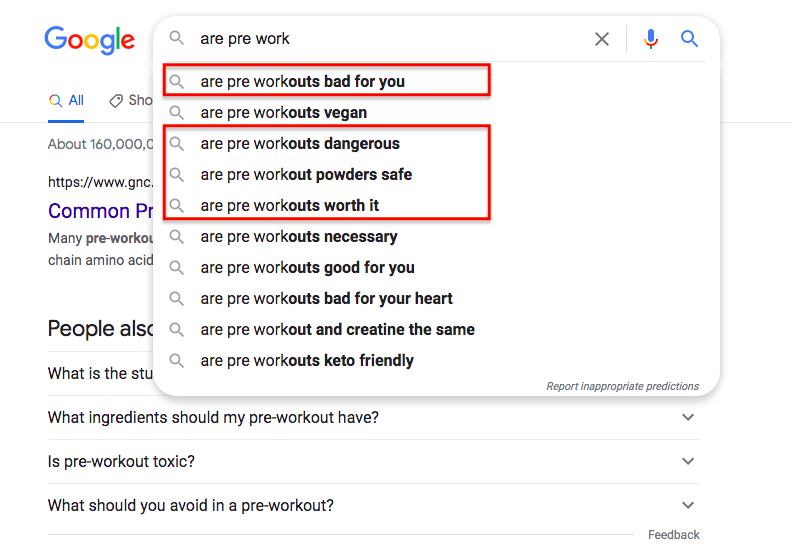
For people who are worried about the ingredients in their pre-workouts, Truwild could show up and discuss the downsides of ingredients in normal pre-workouts, and how their products use natural plant-based ingredients instead.
Here are some examples for the plant-based pain point:
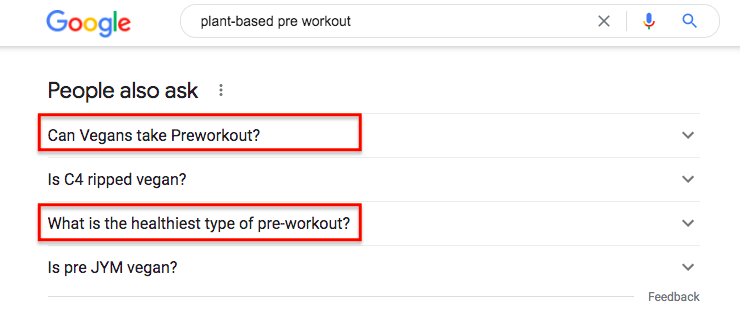
For vegans who are unsure if it’s okay to take pre-workout, Truwild could show up to answer this question and offer their product with plant-based ingredients.
You get the idea here. We’d continue repeating this in Google and keyword research tools and do so for the specific pain points that each of their products solve.
Again, note how although this batch of keywords are one step removed from the absolute bottom of funnel batch discussed earlier, all of these search terms are still about products, meaning the searchers still have product buying intent (you don’t Google “can vegans take pre-workout” unless you are vegan interested in a preworkout drink). So, these terms will still convert way higher than TOF terms with no product buying intent.
Use Case Keywords
Finally, we’d also look for any opportunities where people are searching for how to do a thing that Truwild’s product can help them do.
For example, if someone types in “stay hydrated while…[doing just about anything outdoors]”—it would make a lot of sense for Truwild to show up there with their solution.
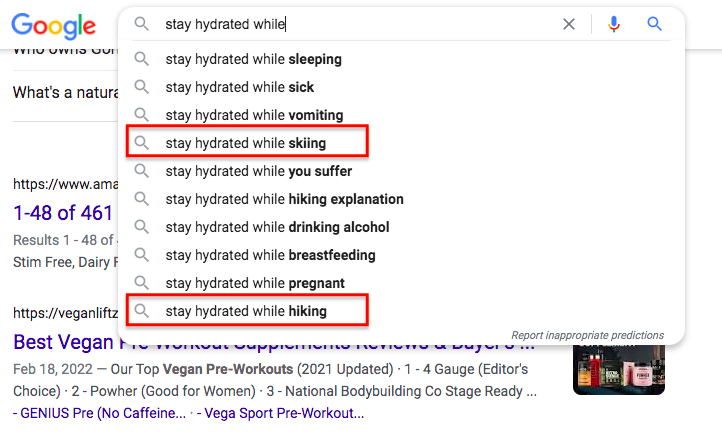
The same goes for if someone types in anything along the lines of “get energy before working out”:
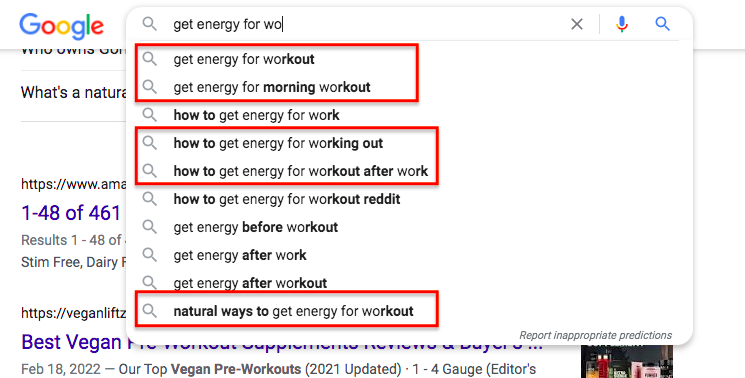
Again, you can imagine how doing this process for both pain points and use cases could easily yield an additional 50-100+ keywords where the right audience is looking to solve something or do something that Truwild can help them do. And you can see how it makes a lot more sense to go after all of these keywords first, before writing about random lifestyle topics that have little to do with your actual product.
Additional Article to Help with Execution
This article has focused on content strategy (i.e. The types of topics and keywords that B2C businesses should focus on when doing content marketing). However, there’s a lot more to execution than just coming up with the ideas. You also need to write the content, promote it, track results, etc.
We’ve written at length about these topics, as well. Check out the following articles to learn how we approach each:
Customer Research
- Customer-Content Fit: A Framework for Producing Content That Attracts Customers
This article discusses the problem of misalignment between the topics B2B SaaS marketers choose to write about, and the topics that would actually appeal to advanced business to business audiences. However, many of the lessons in this piece also apply to B2C.
- Content Ideation: Ways to Come up with Content Ideas That Convert
This article covers tactics for coming up with content ideas, including how to elicit feedback from customers through email, how to find ideas through online communities, how to find keyword ideas from your Adwords account (← this one’s big for B2C businesses) , and more.
Content Writing
- Pain Point Copywriting: How to Write Compelling Sales Copy Inside Blog Posts
Converting readers into customers requires intelligent, thoughtful writing that demonstrates how your product or service solves the customer’s problem. You need to be able to sell your product or service inside blog posts, which is a very different style of blog writing than typical top of funnel how-to or intro-guide style posts. This article shares the biggest mistakes that companies make when it comes to blog copywriting, and walks through an in-depth example of exactly how we approach this at our agency.
- SEO Content Writing: A 5-Step Process You Can Follow
This article shares how we define SEO content writing differently than most SaaS marketers, and lays out our process for repeatedly creating valuable content that ranks in organic search and drives leads.
- The Specificity Strategy: How to Turn Generic Posts into Stand Out Content
People in SaaS marketing always say, “Write great content.” But when you look around online, the typical blogging done by SaaS companies isn’t advanced enough for their audiences. This post explains this problem and our recommendations for what to do instead.
- Why Your Content Needs “Originality Nuggets” to Be Effective
This article explains a concept we call “Originality Nuggets,” which we define as little bits of originality that make a piece of content unique from others, and thus worthy of being shared or linked to. This piece discusses why we created this strategy, how it’s different from our specificity strategy, and provides examples of how originality nuggets look and work in practice.
- Why Fully Outsourcing Blog Writing to Freelance Writers is Flawed
This article discusses a key challenge of creating high-quality content — finding great writers — and our take on how to solve this problem.
Content Promotion
- Content Distribution Strategy: Why We’re Doubling Down on Paid Promotion and SEO
This piece covers the shift we made from community content promotion to focusing exclusively on paid promotion and SEO. We discuss our approach to generating short term traffic to articles via paid ads on social media platforms, as well as long term traffic via SEO and building backlinks.
Measuring Performance
- Most Companies Measure Content Marketing ROI Incorrectly. Here’s Why (and How to Fix It)
This article explains our 4-step process for measuring ROI from content marketing efforts. We cover how to define an actual business metric to measure (not a vanity metric like organic traffic or page views), how to set up Google Analytics, how to calculate the number of leads per month needed to hit breakeven on your spend, and how to track progress. It also includes a free spreadsheet template for tracking your own ROI from content.
- Content Marketing Attribution: How to Measure Content Performance
This article explains the different attribution models that are needed to measure content marketing campaign performance accurately in Google Analytics. Attribution is what gives you insight into what’s working and what’s not so you can base decision making around content on actual data.
Want to work with us or learn more about how we approach content marketing?
- Our Agency: If you want to hire us to execute content marketing in this way, you can learn more about working with us here.
- Join Our Team: If you’re a content marketer or writer and would love to do content marketing in this way, we’d love to have you apply to join our team.
- Our Content Marketing Course: Individuals looking to learn our agency’s content strategy and become better marketers, consultants, or business owners can join our private course, taught via case studies, and presented in both written and video content formats. We include several details and examples not found on this blog. Our course is also built into a community, so people ask questions, start discussions, and share their work in the lesson pages themselves, and we, along with other members, give feedback. Learn more here or watch our video walkthrough here.








